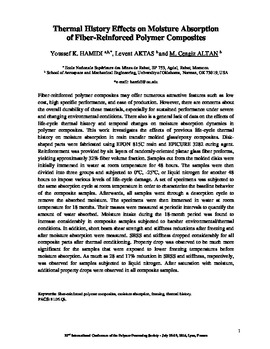| dc.contributor.author | Hamidi, Y. K. | |
| dc.contributor.author | Aktas, L. | |
| dc.contributor.author | Altan, M. C. | |
| dc.date.accessioned | 2016-03-28T19:14:15Z | |
| dc.date.available | 2016-03-28T19:14:15Z | |
| dc.date.issued | 2016 | |
| dc.identifier.citation | Hamidi, Y. K., Aktas, L. and Altan, M. C. Thermal History Effects on Moisture Absorption of Fiber-Reinforced Polymer Composites, Proceedings of the 32nd International Conference of the Polymer processing Society, #S02-329, Lyon, France, July 2016. | en_US |
| dc.identifier.uri | https://hdl.handle.net/11244/33192 | |
| dc.description.abstract | Fiber-reinforced polymer composites may offer numerous attractive features such as low cost, high specific performance, and ease of production. However, there are concerns about the overall durability of these materials, especially for sustained performance under severe and changing environmental conditions. There also is a general lack of data on the effects of life-cycle thermal history and temporal changes on moisture absorption dynamics in polymer composites. This work investigates the effects of previous life-cycle thermal history on moisture absorption in resin transfer molded glass/epoxy composites. Disk-shaped parts were fabricated using EPON 815C resin and EPICURE 3282 curing agent. Reinforcement was provided by six layers of randomly-oriented planar glass fiber preforms, yielding approximately 32% fiber volume fraction. Samples cut from the molded disks were initially immersed in water at room temperature for 48 hours. The samples were then divided into three groups and subjected to 0ºC, -25ºC, or liquid nitrogen for another 48 hours to impose various levels of life-cycle damage. A set of specimens was subjected to the same absorption cycle at room temperature in order to characterize the baseline behavior of the composite samples. Afterwards, all samples went through a desorption cycle to remove the absorbed moisture. The specimens were then immersed in water at room temperature for 18 months. Their masses were measured at periodic intervals to quantify the amount of water absorbed. Moisture intake during the 18-month period was found to increase considerably in composite samples subjected to harsher environmental/thermal conditions. In addition, short beam shear strength and stiffness reductions after freezing and after moisture absorption were measured. SBSS and stiffness dropped considerably for all composite parts after thermal conditioning. Property drop was observed to be much more significant for the samples that were exposed to lower freezing temperatures before moisture absorption. As much as 28 and 17% reduction in SBSS and stiffness, respectively, was observed for samples subjected to liquid nitrogen. After saturation with moisture, additional property drops were observed in all composite samples. | en_US |
| dc.language | en_US | en_US |
| dc.subject | Fiber-reinforced polymer composites | en_US |
| dc.subject | Moisture absorption | en_US |
| dc.subject | Thermal history | en_US |
| dc.subject | Freezing | en_US |
| dc.title | Thermal History Effects on Moisture Absorption of Fiber-Reinforced Polymer Composites | en_US |
| dc.type | Other | en_US |
| dc.description.peerreview | Yes | en_US |
| dc.description.peerreviewnotes | Peer reviewed and accepted for presentation at the 32nd International Conference of the Polymer processing Society. | en_US |
| ou.group | College of Engineering::School of Aerospace and Mechanical Engineering | en_US |
